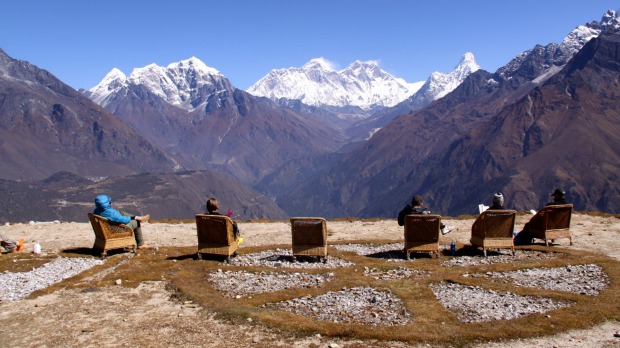
The moment I know I'm unprepared for trekking dawns on me in an outdoor adventure store. Before flying to Kathmandu, I'm trying to look the part. I file past pants with zip-off legs, long-sleeved shirts, striped thermals and waterproof jackets, rubbing their alien high-tech fabrics between my fingers. After an hour, I head to the cash register with just three pairs of hiking socks and hope they'll help somehow.
The new socks are rolled and tucked into my suitcase next to an old pair of tracksuit pants and well-worn T-shirts. I'm trying to ignore a gnawing feeling that I should have bought more and trained more. Work's been so crazy that all I've done is three seven-kilometre power walks at zero metres above sea level.
Aurora Expeditions recommends guests train for at least four months for its Classic Everest Comfort Lodge Trek. The route runs from Lukla to Namche Bazaar before veering north-west to Thame and circling around to Kongde – which is nothing more than two lodges on a high, exposed ridge. On paper the route doesn't sound taxing: just 50 kilometres over eight days, finishing on that ridge from where we'll be helicoptered back to Lukla.
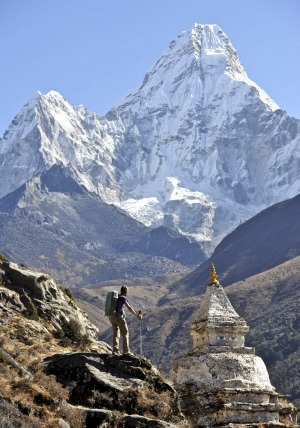
This is my first trip to Nepal but I've heard enough stories from the trail of cold showers, long days, lentil dinners and thin mattresses to realise we're embarking on a luxury trek. Still, the helicopter and ritzy lodges don't quell my anxiety. Mostly, my fears revolve around being the straggler that holds up the group. These fitness fears escalate in Kathmandu – until they're swept aside by a bright-eyed 10-year-old. Izzy from Sydney pops up next to me in the hotel lobby to ask if I'm here for the trek briefing too.
I immediately calm down – if this little girl is trekking the Himalayas then I can too. Izzy's here with her twin brother Max, 15-year-old sister and their parents. Two 61-year-old gents – one from regional NSW and one from Queensland – make up the rest of our group. We've also got a trek leader with fame and form.
Tashi Tenzing Sherpa is the equivalent of trekking royalty in Nepal. His grandfather, Tenzing Norgay, famously joined Edmund Hillary in 1953 in summiting Mount Everest, writing themselves into the history books as the first humans to conquer the 8828-metre-high, oxygen-depleted peak. Following in his grandfather's footsteps, Tashi summited Everest in 1997, 2002 and 2007. Getting eight Australians of various fitness levels to the finish line should be a snip.
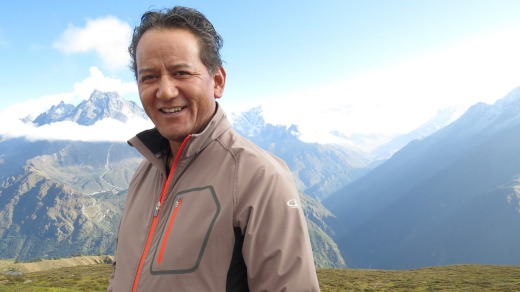
When we finally plop down onto Lukla's infamous short uphill runway from flight from Kathmandu, we let out a collective sigh of relief and head to Lukla Yeti Mountain Home to recover over breakfast. The lodge is the first of six Yeti Mountain Home lodges defining our route and, if bad weather delays our return flight to Kathmandu, we'll spend overnight here.
For now, we fuel up with omelettes and toast. Tashi lived in Australia before moving to Nepal in 2005. He whips out a jar of Vegemite, which wins over the kids. Fed and watered, crunch time arrives. Swinging walking poles and carrying just a day pack (sherpas have gone ahead with most of our luggage), we pass through the National Luminary Pastang Lhamu Memorial Gate into the unknown.
An easy three-hour amble brings us to Phakding – at 2610 metres above sea level, it's lower than Lukla (2840 metres). Along the way, I learn to pass to the left – or clockwise – of the carved prayer stones known as mani that sometimes sit in the middle of the path. We also learn to press ourselves hillside when beasts of burden come our way rather than chancing a tumble down a cliff. Not every bovine with a bell is a yak (they're more suited to Namche Bazaar's higher altitudes). These cow-yak hybrids are known as dzo (male) or dzomo (female).
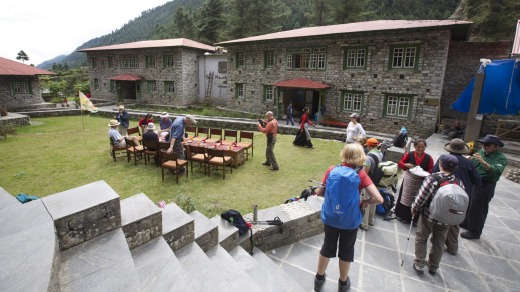
My first day is spent – like countless trekkers before me – slack-jawed with wonder at just how much cargo sherpas can haul along the trail. The most astounding item is the chest-freezer – still in its cardboard box – hanging off someone's head.
Yeti Mountain Home lodges might be billed as comfort lodges but that's an understatement. They appear to be the most luxurious way to bed down along the trail and are a far cry from the basic lodges most trekkers use. The lodges feature spacious rooms where electric blankets warm the beds and artful photographs decorate the walls. Each room comes with its own bathroom (with soap and shampoo though no conditioner) with a limited supply of solar-heated water.
We refill water bottles from jugs of boiled water placed in our rooms. Meals are ridiculously vast: after a day or so of hot breakfasts followed by three-course lunches and dinners, I cut back to cereal-only breakfasts. Glasses of hot water accompany every meal, which doesn't impress Max (he soon swaps to hot chocolates). Grown-ups develop a thing for warm rum punch sundowners and strong masala tea scented with ginger. Some days we're served Nepalese fare (garlic soup, momos, mild curries), on other days Western (jaffles and pizza). The kids try pretty much everything.
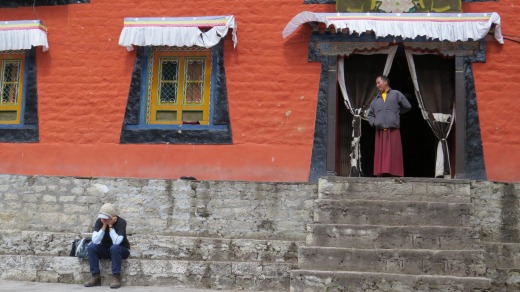
Our first glimpse of Everest is unexpected. We're slogging towards Namche Bazaar when we stop for a hot lemon tea break near an unassuming public toilet block. As we peel off the trail to collapse at our rest stop, we're called over towards a break in the conifers. Right on cue, clouds part to reveal Everest in the distance, a mountain that so captures the human imagination. I never expected to see it in my lifetime so I stand, unblinking, absorbing every nuance of its shape. It doesn't loom over neighbouring peaks in the way I thought it would. Trekkers schlep by on the trail below us with no idea they could see Everest right now if they knew where to look.
Climbing to Namche Bazaar (3440 metres) is our second-hardest day. We arrive just as the market packs up for the day – and still we must keep climbing. Our lodge is perched above the Sherpa capital that sprawls over a horseshoe-shaped amphitheatre. There's Wi-Fi at the lodge – once everyone's checked in with the world, we venture into town to see how we can spend our rupees.
In between countless German bakeries are adventure stores and souvenir shops selling everything from yak bells to knitted beanies. I take a fancy to an embroidered door curtain hanging at the back of a store, separating the retail area from the owner's kitchen. She thinks it's hilarious that of all the door curtains in her store, I want that one. She discounts it and wraps it, laughing the entire time. From Namche Bazaar, we trace the beginning of the trail leading to Everest Base Camp to reach the stupa (or chorten) that commemorates the 50th anniversary of Tenzing Norgay's Everest ascent. Back in town, we explore the Sherpa Culture Museum honouring those who have conquered Everest.
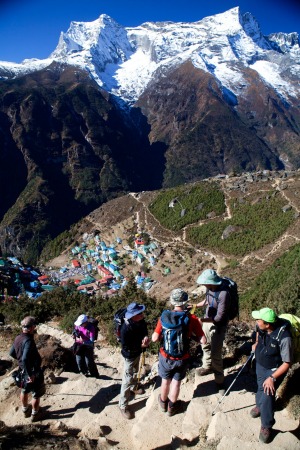
We leave behind the stream of trekkers heading to Everest Base Camp to go in a different direction. For Tashi, there's a highly personal reason to visit Thame: it's where his famous grandfather grew up. Along the way, we slurp a bowl of soup at Dawa Nuru Sherpa's lodge. Dawa has summited Everest so many times that his expedition certificates line an entire wall of his restaurant.
I ask where this accomplished mountaineer is – turns out he's the guy in the yard rinsing dishes. Before posing for my camera, he rakes his fingers through his hair in an effort to look presentable. That humility is echoed in Tenzing Norgay's childhood home. We duck through a tiny doorway into the gloom, climb the stairs and inspect the kitchen, living area and prayer room.
We also ascend to Thame's remote monastery, passing women hoeing potatoes in a field. We're invited to climb the stone wall and join them where Max tries his hand at harvesting spuds. After visiting the monastery, we pass the women again. A baby boy is pulled from his woven basket for photographs. We spot blood pheasants in a field, adding to our count of bird species that includes the iridescent Himalayan monal (Nepal's national bird) and spotted nutcracker.
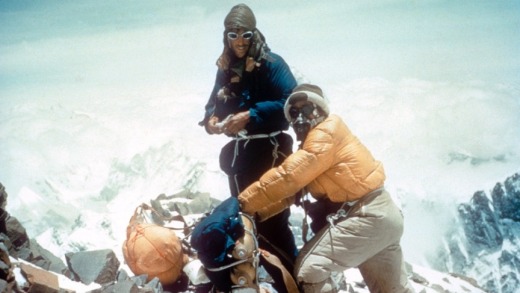
As darkness falls, Tashi tells stories of yetis that reportedly roam these parts, making their trademark whistling sound. We're already having more vivid dreams than usual – some say it's a side-effect of altitude. The kids report the next morning that yetis indeed romped through their dreams.
Climbing from Thame (3800 metres) to Kongde (4250 metres), past moss-covered trees, rhododendron forests and bamboo stands, takes me eight hours. The last hour is miserable. As tiny hailstones pelt me and the other guy puffing away at the back – the twins bounced past long ago – guide Gopal S. Limbu unknowingly provides my favourite moment of the trek. He unzips my daypack to extract a rain poncho. As he pulls it over my head, I realise my nose is running like a tap. I'm so exhausted, so wearied by the elements, that I let it drip. Gopal slides his forefinger under my nose, wiping it for me. His simple act of kindness sums up everything I love about Nepal.
When I first spotted the Kongde lodge from Namche Bazaar, I wondered why anyone would build up there. The answer dawns as we head outside to sit at a long breakfast table on covered chairs tied with yellow ribbons. As we sip champagne, we're staring straight at Everest and nearby peaks such as distinctive Ama Dablam. As we take photos and pinch ourselves, a group of Russians choppers in from Kathmandu. They pop a bottle of Moet, take selfies in front of Everest and fly off again. We can't help but feel smug that we earned this view the hard way.
The next morning it's our turn to dramatically exit via chopper. We whoosh down off the ridge, heading straight towards Everest. We fly over turquoise lakes, the Khumbu Glacier and an Everest-shaped shadow. I spot a few permanent buildings that could be the trekking lodges of Gorakshep, the original Everest base camp. At Lukla Airport, we're still buzzing from the chopper ride of a lifetime as we watch planes from Kathmandu decanting a new set of trekkers yet to get themselves dirty.
Back in Sydney, I meet up with the twins' mum and the NSW trekker who didn't bring a camera. I've sent him photos from our trip. "The scenery was amazing," he says, sounding surprised. "I think I spent most of the time looking down at my feet." I ask the twins' mother what the kids have talked about since returning home. "They were really surprised how simple life was over there – that people do things like going outside to wash their dishes under a tap," she says. "They also noticed that the kids in Nepal didn't have much but they were still happy."
The indomitable twins couldn't possibly know it but they taught me something too. When it comes to conquering mountains it's your attitude - not the altitude - that matters most.
Panoramic coastal and mountain tracks link five picture-postcard villages clinging to 17 kilometres of almost-vertical Mediterranean coastline. The distance might sound easy but walkers must conquer many steep stone steps along the way. If it all gets too much, take the inter-village train to reach the next gelato stop. Vernazza bore the brunt of devastating storms in 2011 but its walking trails reopened last year. See parconazionale5terre.it.
The most popular of the five main pilgrimage routes – Camino Frances – starts on the French side of the Pyrenees and meanders across northern Spain. If walking almost 800 kilometres to Santiago de Compostela sounds a little too challenging, Adventure World's 11-day taste of trail life starts from Leon. From $2274 a person; see adventureworld.com.au.
Most visitors to Peru want to see one thing: the magnificent Incan ruins of Machu Picchu, tucked away in such a remote spot in the Andes that they were only rediscovered in 1911. Trek to the high-altitude 15th-century ruins with the help of Intrepid Travel – its seven-day Inca Trail Express tour starts costs $1125 a person twin-share. See intrepidtravel.com.
See some of the Red Centre's most fascinating geological features - Simpsons Gap, Standley Chasm and Ormiston Pound - while carrying nothing more than a daypack. World Expeditions' six-day Classic Larapinta Trek features overnight stays in two architect-designed permanent campsites; guides also double as gourmet cooks. From $2295 a person; see worldexpeditions.com.
Tramp the country's most famous trail to see perfect South Island fjord and alpine scenery. The easy to intermediate 53.5-kilometre trail takes hikers past granite canyons, mirror-like lakes and cascading waterfalls. Those who'd like a guide can join Ultimate Hikes' five-day trip that finishes with a cruise on Milford Sound. From $1930 a person multi-share; see ultimatehikes.co.nz.
1. See a doctor well before departure for a check-up and to discuss vaccination requirements and altitude-sickness preventatives. Some treks require medical clearance.
2 Train to minimise pain. Walk a few kilometres a day before heading off to build up muscle strength and to ensure boots don't cause blisters.
3. Blister care. Pack a needle and thread into your medical kit – run the thread through any blister, leaving the thread behind to drain fluid while minimising the chance of infection.
4. Hydrate. Keep your water bottle handy and keep drinking even if you don't feel thirsty. It's easy to dehydrate at altitude.
5. Keep hands clean. Trail life can be fun but, after you've patted the dogs, played with the kids and ducked behind a bush, apply hand sanitiser – or you may need those anti-diarrhoea pills.
welcomenepal.com; smartraveller.gov.au
China Southern flies twice daily from Sydney and 10 times a week from Melbourne to Guangzhou, and connects to Kathmandu. See csair.com.au.
Aurora's 13-day Classic Everest Comfort Lodge Trek starts in Kathmandu on April 14, May 5, September 22 and October 6. It costs $US4100 ($5050) a person twin-share. See auroraexpeditions.com.au.
The tour includes pre and post-trek accommodation at the luxury Gokarna Forest Resort on Kathmandu's outskirts. See gokarna.com.
Ask your doctor about preventative treatments for altitude sickness. Symptoms include headache, nausea and loss of appetite. Aurora's guides monitor trekkers' blood oxygen levels each day via a clip-on finger pulse oximeter.
The writer was a guest of Aurora Expeditions and China Southern Airlines.